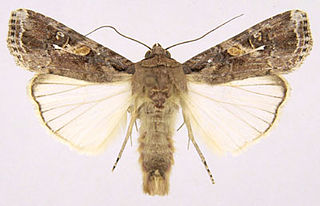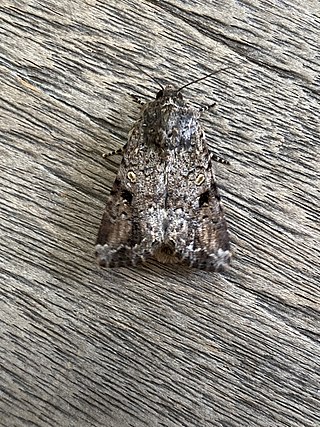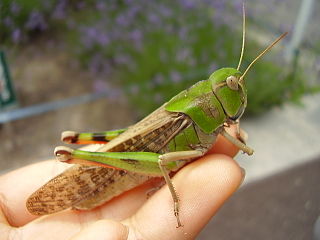
Orthoptera is an order of insects that comprises the grasshoppers, locusts, and crickets, including closely related insects, such as the bush crickets or katydids and wētā. The order is subdivided into two suborders: Caelifera – grasshoppers, locusts, and close relatives; and Ensifera – crickets and close relatives.

Locusts are various species of short-horned grasshoppers in the family Acrididae that have a swarming phase. These insects are usually solitary, but under certain circumstances they become more abundant and change their behaviour and habits, becoming gregarious. No taxonomic distinction is made between locust and grasshopper species; the basis for the definition is whether a species forms swarms under intermittently suitable conditions; this has evolved independently in multiple lineages, comprising at least 18 genera in 5 different subfamilies.

The Rocky Mountain locust is an extinct species of grasshopper that ranged through the western half of the United States and some western portions of Canada with large numbers seen until the end of the 19th century. Sightings often placed their swarms in numbers far larger than any other locust species, with one famous sighting in 1875 estimated at 198,000 square miles (510,000 km2) in size, weighing 27.5 million tons and consisting of some 12.5 trillion insects, the greatest concentration of animals ever speculatively guessed, according to Guinness World Records.
The Australian Plague Locust Commission (APLC) is a joint venture of the Australian Government and the member states of New South Wales, Victoria, South Australia and Queensland, created in 1974 to manage outbreaks of the Australian plague locust, spur-throated locust and migratory locust in eastern Australia. With 19 staff members at its headquarters in Canberra and field offices in Narromine, Broken Hill and Longreach, it is jointly funded by the Commonwealth government and by the Australian states of New South Wales, Victoria, South Australia and Queensland.

Grasshoppers are a group of insects belonging to the suborder Caelifera. They are amongst what are possibly the most ancient living groups of chewing herbivorous insects, dating back to the early Triassic around 250 million years ago.

The desert locust is a species of locust, a periodically swarming, short-horned grasshopper in the family Acrididae. They are found primarily in the deserts and dry areas of northern and eastern Africa, Arabia, and southwest Asia. During population surge years, they may extend north into parts of Southern Europe, south into Eastern Africa, and east in northern India. The desert locust shows periodic changes in its body form and can change in response to environmental conditions, over several generations, from a solitary, shorter-winged, highly fecund, non-migratory form to a gregarious, long-winged, and migratory phase in which they may travel long distances into new areas. In some years, they may thus form locust plagues, invading new areas, where they may consume all vegetation including crops, and at other times, they may live unnoticed in small numbers.

The migratory locust is the most widespread locust species, and the only species in the genus Locusta. It occurs throughout Africa, Asia, Australia and New Zealand. It used to be common in Europe but has now become rare there. Because of the vast geographic area it occupies, which comprises many different ecological zones, numerous subspecies have been described. However, not all experts agree on the validity of some of these subspecies.
In 2004, West and North Africa experienced their largest infestation of desert locusts in more than 15 years. A number of countries in the fertile northern regions of Africa were affected.

The Mormon cricket is a large insect native to western North America in rangelands dominated by sagebrush and forbs. Anabrus is a genus in the shield-backed katydid subfamily in the Tettigoniidae family, commonly called katydids, bush crickets, and previously "long-horned grasshoppers". Its common name, "Mormon cricket", is a misnomer: true crickets are of the family Gryllidae.

The red locust is a large grasshopper species found in sub-Saharan Africa. Its name refers to the colour of its hind wings. It is sometimes called the criquet nomade in French, due to its nomadic movements in the dry season. When it forms swarms, it is described as a locust.

From March to October 1915, swarms of locusts stripped areas in and around Palestine, Mount Lebanon and Syria of almost all vegetation. This infestation seriously compromised the already-depleted food supply of the region and sharpened the misery of all Jerusalemites.

The Australian plague locust is a native Australian insect in the family Acrididae, and a significant agricultural pest.

The fall armyworm is a species in the order Lepidoptera and one of the species of the fall armyworm moths distinguished by their larval life stage. The term "armyworm" can refer to several species, often describing the large-scale invasive behavior of the species' larval stage. It is regarded as a pest and can damage and destroy a wide variety of crops, which causes large economic damage. Its scientific name derives from frugiperda, which is Latin for lost fruit, named because of the species' ability to destroy crops. Because of its propensity for destruction, the fall armyworm's habits and possibilities for crop protection have been studied in depth. It is also a notable case for studying sympatric speciation, as it appears to be diverging into two species currently. Another remarkable trait of the larva is that they consistently practice cannibalism, despite its fitness costs.

Spodoptera mauritia, the lawn armyworm or paddy swarming caterpillar, is a moth of the family Noctuidae. The species was first described by Jean Baptiste Boisduval in 1833. Able to eat many types of food, it is a major pest throughout the world.

Dociostaurus maroccanus, commonly known as the Moroccan locust, is a grasshopper in the insect family Acrididae. It is found in northern Africa, southern and eastern Europe and western Asia. It lives a solitary existence but in some years its numbers increase sharply, and it becomes gregarious and congregates to form swarms which can cause devastation in agricultural areas. The species was first described by Carl Peter Thunberg in 1815.

Locusta migratoria manilensis, commonly known as the Oriental migratory locust, is a subspecies of the migratory locust in the family Acrididae. It is sufficiently different in size and structure from the African migratory locust to be considered a distinct subspecies of the migratory locust. It is found in southeastern Asia and is an important agricultural pest in the region. It is normally a solitary insect but when conditions are suitable, it enters into a gregarious phase when the young form into bands which move together and the adults into swarms. Although outbreaks may have recently been fewer in number and size because of changes in agricultural practices and better locust detection, the insects remain active as crop pests and the potential for outbreaks is still present.
In January 2016, Argentina faced the largest locust swarm for over 60 years. Diego Quiroga, Argentina's agriculture agency’s chief of vegetative protection, said that it was impossible to eradicate the swarm, so they focused on minimizing the damage caused by it by sending out fumigators equipped with backpack sprayers to exterminate small pockets of young locusts that are still unable to fly. This method of extermination, however, is unable to wipe out pocket of locusts hidden in Argentina's large, dry forests. The swarm covered an area the size of 1,900 square miles (5,000 km2) in Northern Argentina. The locusts were expected to grow ten inches (25 cm) and mature into flying swarms by 5 February.

Between June 2019 and February 2022, a major outbreak of desert locusts began developing, threatening food supplies in East Africa, the Arabian Peninsula and the Indian subcontinent. The outbreak was the worst to hit Kenya in 70 years, and the worst in 25 years for Ethiopia, Somalia, and India.
This is an environmental history of the 2020s. Environmental history refers to events and trends related to the natural environment and human interactions with it. Examples of human-induced events include biodiversity loss, climate change and holocene extinction.

The Locust Plague of 1874, or the Grasshopper Plague of 1874, occurred when hordes of Rocky Mountain locusts invaded the Great Plains in the United States and Canada. The locust hordes covered about 2,000,000 square miles (5,200,000 km2) and caused millions of dollars' worth of damage. The swarms were so thick that they could cover the sun for up to six hours.
















